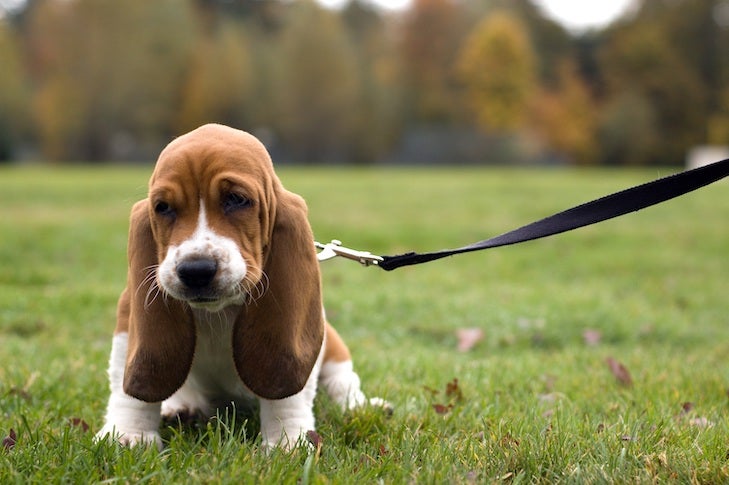AKC is a participant in affiliate advertising programs designed to provide a means for sites to earn advertising fees by advertising and linking to akc.org. If you purchase a product through this article, we may receive a portion of the sale.
Many people think that dogs just innately know how to walk politely on a leash. But this skill is something that needs to be trained. It’s an important skill to teach, and one you’ll value every time you take your dog out for a walk. Dog training expert and AKC Family Dog training and behavior columnist Kathy Santo offers the following tips:
Training Your Dog to Walk on a Leash
Follow these steps to set a solid foundation for any future walks with your dog:
Introduce the Puppy to the Collar or Harness and Leash
Start by letting them get used to wearing a collar or harness and a leash. Let them wear them for short periods of time in the house while you’re playing with them and giving them treats. The puppy should love collar-and-leash time because it represents food and fun.
Teach a Cue
Introduce your puppy to a sound cue that means, “Food is coming.” Some people like to click and treat, some people use a word like “yes,” and some people cluck their tongues. Whichever you use, the method is the same: In a quiet, distraction-free area, with the puppy on a leash and collar, make the sound. The second your puppy turns toward or looks at you, reward them with a treat. After a few repetitions, you’ll notice your puppy not only looking at you but also coming over to you for the treat.

Make the Puppy Come To You
While they’re on their way to you, still wearing the leash and collar, back up a few paces. Then reward them when they get to you. Continue the progression until your puppy, upon hearing the cue noise, comes to you and walks with you a few paces. Remember that puppies have a short attention span. Keep your sessions short, and end them when your puppy is still eager to do more, not when they feel mentally exhausted.
Practice Inside
Now that your puppy understands how to come to you, practice walking a few steps in a room with little distraction. Feeling and seeing the leash around them will be enough of a challenge. Offer treats and praise as your puppy learns to come to you, with a leash on.
Take It Outside
Finally, you’re ready to test your puppy’s skills in the great outdoors. There will be new challenges with this step because all the sounds, smells, and sights your puppy encounters will be intriguing and new to them. Be patient and keep the first walks short. While you’re on a walk, if your puppy looks like they’re about to lunge toward something or is about to get distracted (you’ll notice this because you’ll keep your eyes on them at all times), make your cue sound and move a few steps away. Then reward them with a treat for following you.

Leash-Training Troubleshooting
Even though your puppy may be learning to walk on a leash very nicely, you’re likely to run into some issues as they get older, go to new places, and experience new distractions. You’ll want to teach them loose-leash walking because it’s much more pleasant for you both, and also then can pass their Canine Good Citizen test. Here are a few tips on what to do if you’re having trouble with leash training, courtesy of the AKC GoodDog! Helpline.
If Your Puppy Pulls
If your dog starts pulling in the other direction, turn yourself into “a tree.” Stand very still and refuse to move until your dog comes back to you. Don’t yank or jerk the leash or drag your dog along with you. Front-hook harnesses and head halters are alternative training tools designed for dogs that tend to pull.
If Your Puppy Lunges
If your dog is going after something while on a walk — another dog, a car, a skateboarder, for example, be proactive. Try to redirect their attention with a treat before they have a chance to lunge. Increase the space between your dog and the target. Stay alert and be prepared before the target of their frustration gets too close. This type of behavior may be more common in herding breeds, but any dog can be startled by something they’re not used to or find exciting.
If Your Puppy Barks
Some dogs have the habit of barking at other dogs while on a walk. Oftentimes, this behavior comes as a result of a lack of exercise. Make sure your dog gets the proper amount of mental and physical stimulation for their age and breed. If this is still a problem, use the same process as you would if your dog is lunging. Create distance and offer treats before they start to bark. Every time they see another dog, they’ll get used to turning their attention to you.
Gradually you’ll reduce the number of treats and the amount of troubleshooting that your puppy needs during a walk. It’s a good idea to keep some on hand at all times so you can randomly reinforce good leash-walking behavior.
Need help with your adorable new puppy? Training your dog can be challenging without expert help. That’s why we’re here to help you virtually, through AKC GoodDog! Helpline. This live telephone service connects you with a professional trainer who will offer unlimited, individualized advice on everything from house-training to behavioral issues.

